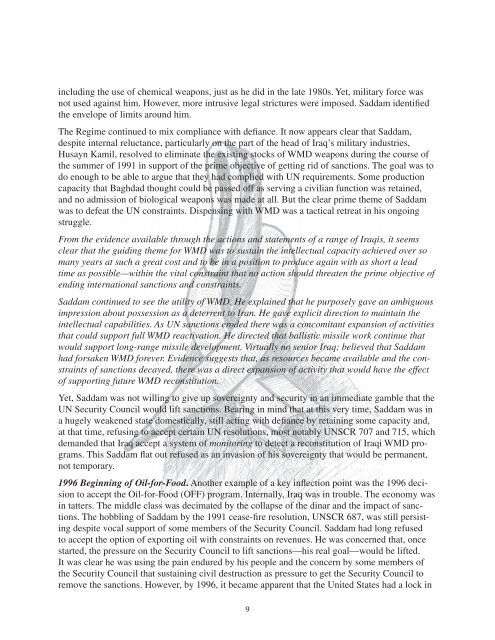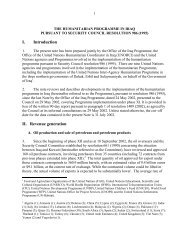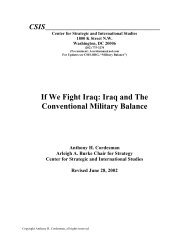- Page 1 and 2: Comprehensive Reportof the Special
- Page 3 and 4: versus another. They deserve at lea
- Page 5 and 6: In Saddam’s view, Iraq was the na
- Page 7 and 8: UNSCOM gave a sufficiently positive
- Page 9: The Regime, drawing on the experien
- Page 14 and 15: Acknowledgements(12 September 2004
- Page 18 and 19: Scope NoteThis report relays Iraq S
- Page 20 and 21: power to secure the various sites t
- Page 22: circumstances. Others are charged w
- Page 25 and 26: This page intentionally left blank.
- Page 27 and 28: Desire . . . Dominance and Deterren
- Page 29 and 30: This page intentionally left blank.
- Page 31 and 32: Note on Methodological ApproachInte
- Page 33 and 34: This page intentionally left blank.
- Page 35 and 36: Key Iraqi Organizations and Officia
- Page 37 and 38: • Party and governmental organiza
- Page 39 and 40: • Saddam also wrote key speeches
- Page 41 and 42: • Hikmat Mizban Ibrahim Al ‘Azz
- Page 43 and 44: After the Ba’thist seizure of pow
- Page 45 and 46: • The RCC represented the outer l
- Page 47 and 48: Saddam Holding CourtSaddam made she
- Page 49 and 50: • ‘Ali Hasan Al Majid noted Sad
- Page 51 and 52: family, who was not necessarily com
- Page 53 and 54: he may have said he had the desire,
- Page 55 and 56: dan, one of Saddam’s more indepen
- Page 57 and 58: Iraq began a nuclear program shortl
- Page 59 and 60: Iraqi Intelligence Collection Again
- Page 61 and 62:
dad wanted a dialogue with the Unit
- Page 63 and 64:
that will match the weapons used ag
- Page 65 and 66:
their influence with their governme
- Page 67 and 68:
Iraq’s Surcharge on Oil and Regim
- Page 69 and 70:
Iraq’s Relationship With FranceTh
- Page 71 and 72:
of it borrowed from Gulf neighbors
- Page 73 and 74:
Scientific Research and Intention t
- Page 75 and 76:
Husayn Kamil (continued)to return t
- Page 77 and 78:
1995, and again in 1999, under orde
- Page 79 and 80:
The Saga of the “Chicken Farm”
- Page 81 and 82:
Security ServicesInstruments of Den
- Page 83 and 84:
VX Warhead Samples & The Iraqi Air
- Page 85 and 86:
including monitoring, on 31 October
- Page 87 and 88:
• According to ‘Abd Hamid Mahmu
- Page 89 and 90:
• Saddam stated to his ministers
- Page 91 and 92:
tive Chairman Hans Blix, IAEA Direc
- Page 93 and 94:
tion Plan approved under UNSCR 715
- Page 95 and 96:
and after that I will take over.”
- Page 97 and 98:
mented that all systems broke down
- Page 99 and 100:
How Much Power and Influence?The Qu
- Page 101 and 102:
• Opposition to Israel was ritual
- Page 103 and 104:
The Iraqi IntelligenceServiceIIS St
- Page 105 and 106:
Structure of M5• M5/1 Iran, Turke
- Page 107 and 108:
From 1980-1990, M9 developed chemic
- Page 109 and 110:
The Evolution of the Former M9/J De
- Page 111 and 112:
M22, Directorate of Protective Serv
- Page 113 and 114:
This page intentionally left blank.
- Page 115 and 116:
‘Izzat Ibrahim Al DuriChairman‘
- Page 117 and 118:
Qusay stepped down as the Director
- Page 119 and 120:
Duties of the SSO Palace SecurityTh
- Page 121 and 122:
The Security UnitThe SSO had a batt
- Page 123 and 124:
Republican Guard Organizational Str
- Page 125 and 126:
This page intentionally left blank.
- Page 127 and 128:
Husayn Kamil: No, we have some of t
- Page 129 and 130:
Husayn Kamil: Sir, these vital loca
- Page 131 and 132:
This page intentionally left blank.
- Page 133 and 134:
How Surcharges Were Collected .....
- Page 135 and 136:
Methods Used To Hide Transshipment
- Page 137 and 138:
This page intentionally left blank.
- Page 139 and 140:
• Once money began to flow into I
- Page 141 and 142:
This page intentionally left blank.
- Page 143 and 144:
This page intentionally left blank.
- Page 145 and 146:
providing the Iraq population with
- Page 147 and 148:
Table 1A Selection of Oil Vouchers
- Page 149 and 150:
Budgeting Iraqi ProcurementOff-budg
- Page 151 and 152:
The Economic Affairs Committee (EAC
- Page 153 and 154:
information or justification, were
- Page 155 and 156:
Figure 5. Iraqi illicit revenue sou
- Page 157 and 158:
matters was illustrated when the go
- Page 159 and 160:
• Illicit barrel surcharges on oi
- Page 161 and 162:
10 June 2000. The relationship prob
- Page 163 and 164:
• The first contract under the Pr
- Page 165 and 166:
Tariq AzizFormer Deputy Prime Minis
- Page 167 and 168:
Mr. ZierbekMr. Azakov andMr. Vellos
- Page 169 and 170:
Iraq’s Oil Allocation Voucher Pro
- Page 171 and 172:
Fa’iq AhmadSharifAndMastekMillion
- Page 173 and 174:
amounted to about $2 million. Becau
- Page 175 and 176:
Bank of Jordan. SOMO created separa
- Page 177 and 178:
utilized elsewhere. The signature a
- Page 179 and 180:
Figure 29. Total amounts received u
- Page 181 and 182:
Figure 31. Total amounts received i
- Page 183 and 184:
Figure 33. Total assets in Iraq’s
- Page 185 and 186:
Iraqi importer would verify accepta
- Page 187 and 188:
• The Regime implemented the gold
- Page 189 and 190:
Lebanon, to its vault in Baghdad vi
- Page 191 and 192:
that Iraq would strengthen its coop
- Page 193 and 194:
Muhammad Mahdi Al Salih, the former
- Page 195 and 196:
Jordanian Case StudyCommercial atta
- Page 197 and 198:
• Taleb Uwayn Al-Juma’a, the Ch
- Page 199 and 200:
Figure 38. The MIC-MoD Special Comm
- Page 201 and 202:
office handling mail between MIC an
- Page 203 and 204:
Muzahim Sa’ab al-Hasan al-NasiriF
- Page 205 and 206:
• Ties flourished after the death
- Page 207 and 208:
MIC Front CompaniesThe MIC used fro
- Page 209 and 210:
The IIS used the Al-Basha’ir fron
- Page 211 and 212:
Figure 45. Chemicals for liquid pro
- Page 213 and 214:
Procurement LeadersProcurement Lead
- Page 215 and 216:
• The IIS completely controlled a
- Page 217 and 218:
• The term “Trade Office” was
- Page 219 and 220:
ILTC subordinate company seems to h
- Page 221 and 222:
• According to a high-level Iraqi
- Page 223 and 224:
Iraqi front companies with a number
- Page 225 and 226:
• Another of Sattam’s brothers,
- Page 227 and 228:
This page intentionally left blank.
- Page 229 and 230:
2003 refl ects only January to Marc
- Page 231 and 232:
tion, Ukrainian state and private e
- Page 233 and 234:
Figure 55. A document, dated April
- Page 235 and 236:
• ARMOS specialized in bringing b
- Page 237 and 238:
The MIC maintained bank accounts in
- Page 239 and 240:
SES International reportedly was th
- Page 241 and 242:
Figure 58. Allocation of the goods
- Page 243 and 244:
Most of the illegal transactions in
- Page 245 and 246:
axis turntable for testing gyroscop
- Page 247 and 248:
ISG uncovered further conventional
- Page 249 and 250:
Figure 59. JEFF Company contracts,
- Page 251 and 252:
In 2001 Iraq used the Syrian Protoc
- Page 253 and 254:
Figure 61. Military goods Iraq acqu
- Page 255 and 256:
• The missile contracts in 2001 w
- Page 257 and 258:
y Polish police included Ewex contr
- Page 259 and 260:
company’s activities in 2001, New
- Page 261 and 262:
• Belarus acquired hard currency
- Page 263 and 264:
IAEC—MIC Cooperation for the Proc
- Page 265 and 266:
In 2001, the IAEC and MIC were work
- Page 267 and 268:
opposition parties for this action
- Page 269 and 270:
Figure 64. A bill of lading from Oc
- Page 271 and 272:
Circumvention of UN Sanctions Impor
- Page 273 and 274:
Syria’s two primary transportatio
- Page 275 and 276:
140Figure 65. A truck holdingarea n
- Page 277 and 278:
Smuggling via Syrian PortsOpen sour
- Page 279 and 280:
This page intentionally left blank.
- Page 281 and 282:
An ISG Translation of the 2003 Iraq
- Page 283 and 284:
And a follow up on supplying crude
- Page 285 and 286:
An ISG Translation of the 2003 Iraq
- Page 287 and 288:
Sixthly:Transporting the imported q
- Page 289 and 290:
Syria-Iraq Trade ProtocolThe Iraq-S
- Page 291 and 292:
156Figure 1. The Iraq-SyriaTrade Pr
- Page 293 and 294:
Figure 3. The Iraq-TurkeyTrade Prot
- Page 295 and 296:
Figure 3. The Iraq-TurkeyTrade Prot
- Page 297 and 298:
Figure 3. The Iraq-TurkeyTrade Prot
- Page 299 and 300:
Figure 3. The Iraq-TurkeyTrade Prot
- Page 301 and 302:
This page intentionally left blank.
- Page 303 and 304:
Oil Allocation RecipientListThe nam
- Page 305 and 306:
Oil Allocation RecipientList (conti
- Page 307 and 308:
Oil Allocation RecipientList (conti
- Page 309 and 310:
Oil Allocation RecipientList (conti
- Page 311 and 312:
Oil Allocation RecipientList (conti
- Page 313 and 314:
Oil Allocation RecipientList (conti
- Page 315 and 316:
Oil Allocation RecipientList (conti
- Page 317 and 318:
Oil Allocation RecipientList (conti
- Page 319 and 320:
Oil Allocation RecipientList (conti
- Page 321 and 322:
Oil Allocation RecipientList (conti
- Page 323 and 324:
Oil Allocation RecipientList (conti
- Page 325 and 326:
Oil Allocation RecipientList (conti
- Page 327 and 328:
Oil Allocation RecipientList (conti
- Page 329 and 330:
Oil Allocation RecipientList (conti
- Page 331 and 332:
Oil Allocation RecipientList (conti
- Page 333 and 334:
Oil Allocation RecipientList (conti
- Page 335 and 336:
Oil Allocation RecipientList (conti
- Page 337 and 338:
Mullah Huwaysh was the vice chairma
- Page 339 and 340:
Figure 4. The Iraqi general budgetp
- Page 341 and 342:
This page intentionally left blank.
- Page 343 and 344:
Figure 6. Estimated GDP/real GDP in
- Page 345 and 346:
Industrial Diversification and Manu
- Page 347 and 348:
Figure 12. Foreign debt,1989-2003.F
- Page 349 and 350:
Figure 14. Balance ofpayments: over
- Page 351 and 352:
This page intentionally left blank.
- Page 353 and 354:
aaThe UN was aware of the Jordanian
- Page 355 and 356:
This page intentionally left blank.
- Page 357 and 358:
Smuggler “Volgoneft-147”Figure
- Page 359 and 360:
B) Second party committed to pay th
- Page 361 and 362:
226Figure 21. Summary of aletter fr
- Page 363 and 364:
228Figure 22. Contractbetween the N
- Page 365 and 366:
230Figure 23. Personal letterfrom M
- Page 367 and 368:
232Figure 25 . Second letterfrom A.
- Page 369 and 370:
234Figure 26. Two checks toMax Moin
- Page 371 and 372:
236Figure 27. Contract forpetroleum
- Page 373 and 374:
238Figure 28. Letter addressedto Mu
- Page 375 and 376:
240Figure 29. Contractbetween al Ba
- Page 377 and 378:
242Figure 30. Letterauthorizing the
- Page 379 and 380:
Figure 32 shows a contract between
- Page 381 and 382:
246Figure 32. Unipack ofParis contr
- Page 383 and 384:
248Figure 34. First Yu SwissBank Be
- Page 385 and 386:
This page intentionally left blank.
- Page 387 and 388:
252Figure 36. Iraqi bankingsystem s
- Page 389 and 390:
The CBI did not make extra payments
- Page 391 and 392:
This page intentionally left blank.
- Page 393 and 394:
without delay the entry into or tra
- Page 395 and 396:
authorized to sell or supply any co
- Page 397 and 398:
ported to be the Iraqi General Comp
- Page 399 and 400:
Possible Breaches of UN Sanctions b
- Page 401 and 402:
This page intentionally left blank.
- Page 403 and 404:
Possible Breaches of UN Sanctions b
- Page 405 and 406:
Letters Dealing With a Planned Visi
- Page 407 and 408:
• At the 3 November 2002 meeting,
- Page 409 and 410:
11 August 1999 Handwritten Document
- Page 411 and 412:
to an earlier meeting held in Pyong
- Page 413 and 414:
• Huwaysh claimed that Iraq had c
- Page 415 and 416:
contract reads “as for the second
- Page 417 and 418:
ing Iraqi air defense officials.•
- Page 419 and 420:
—The company shall issue a credit
- Page 421 and 422:
cializes in air defense; Georgi Ser
- Page 423 and 424:
Possible Breaches of UN Sanctions b
- Page 425 and 426:
This page intentionally left blank.
- Page 427 and 428:
Al-HusanAl-Hussaini Company for Tra
- Page 429 and 430:
Nurallah CompanyOrkid General Tradi
- Page 431 and 432:
CWDETADGMIDGSDIADiwanDMIDOCEXDPRKEA
- Page 433 and 434:
MoIMoOMoTMoTCMOUNORINCONSCNVDNVGOFF
- Page 436 and 437:
Regime Strategy and WMD Timeline Ev
- Page 438 and 439:
Regime Strategy and WMD Timeline Ev
- Page 440 and 441:
Regime Strategy and WMD Timeline Ev
- Page 442 and 443:
Regime Strategy and WMD Timeline Ev
- Page 444 and 445:
Regime Strategy and WMD Timeline Ev
- Page 446 and 447:
Regime Strategy and WMD Timeline Ev
- Page 448 and 449:
Regime Strategy and WMD Timeline Ev
















